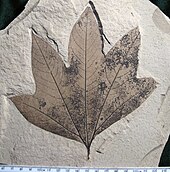Plants
Ferns and fern allies
| Name | Novelty | Status | Authors | Age | Unit | Location | Synonymized taxa | Notes | Images |
|---|---|---|---|---|---|---|---|---|---|
Sp nov | A horsetail species. | ||||||||
Flowering plants
Magnoliids
| Name | Novelty | Status | Authors | Age | Unit | Location | Synonymized taxa | Notes | Images |
|---|---|---|---|---|---|---|---|---|---|
Sp nov | A Machilus species. | ||||||||
Sp nov | A Machilus species. | ||||||||
Comb nov | synonymy
| A Magnolia species. | |||||||
Monocots
| Name | Novelty | Status | Authors | Age | Unit | Location | Synonymized taxa | Notes | Images |
|---|---|---|---|---|---|---|---|---|---|
Syn nov |
| A greenbriar species. | |||||||
Basal Eudicots and unplaced core Eudicots
| Name | Novelty | Status | Authors | Age | Unit | Location | Synonymized taxa | Notes | Images |
|---|---|---|---|---|---|---|---|---|---|
Sp nov | jr synonym | Brown | First described as a Tetracera species. | ||||||
Comb nov | (Knowlton) Brown | synonymy
| A grape species |  | |||||
Superasterids - basal
| Name | Novelty | Status | Authors | Age | Unit | Location | Notes | Images | |
|---|---|---|---|---|---|---|---|---|---|
Comb nov | Phyllites peculiaris | A Philadelphus species. |  | ||||||
Comb nov | synonymy
| A Vaccinium species. |  | ||||||
Superasterids
| Name | Novelty | Status | Authors | Age | Unit | Location | Synonymized taxa | Notes | Images |
|---|---|---|---|---|---|---|---|---|---|
Nom nov. | jr synonym | Aralia whitneyi non Lesquereux nec Berry, (1929) | First named as an Aralia species. |  | |||||
Comb nov | synonymy
| An Arbutus species. | |||||||
Comb nov | synonymy
| A Hydrangea species. | |||||||
Comb nov | Strawberry Volcanics | synonymy
| An Oregon grape species. | ||||||
Comb nov | A viburnum species. | ||||||||
Syn nov | Aesculus hesperia Berry (1929) | A viburnum species. | |||||||
Superrosids
| Name | Novelty | Status | Authors | Age | Unit | Location | Synonymized taxa | Notes | Images |
|---|---|---|---|---|---|---|---|---|---|
Syn nov | synonymy
| A maple species. | |||||||
Syn nov | John Day Formation | synonymy
| A maple species. | ||||||
Syn nov | John Day Formation | Alnus prerhombifolia Berry (1929) | An alder species. |  | |||||
Comb nov | synonymy
| An alder species. |  | ||||||
Comb nov | A birch species. |  | |||||||
Sp nov | |||||||||
Comb nov | A hickory species. | ||||||||
Syn nov | A cotton-easter species. | ||||||||
Sp nov | A sapindaceous species. | ||||||||
Comb nov | Jr synonym | synonymy
| A sapindaceous species. | ||||||
Syn nov | A beech species. | ||||||||
Syn nov | Acalypha myricina | A rhamnaceous species. | |||||||
Comb nov | A wingnut species. | ||||||||
Comb et syn nov | A willow species. |  | |||||||
Comb nov | synonymy
| A Zelkova species. | |||||||
Angiosperms - other
| Name | Novelty | Status | Authors | Age | Unit | Location | Synonymized taxa | Notes | Images |
|---|---|---|---|---|---|---|---|---|---|
Comb nov | valid? | Latah Formation | A fruit or seed of uncertain affinity |  |




